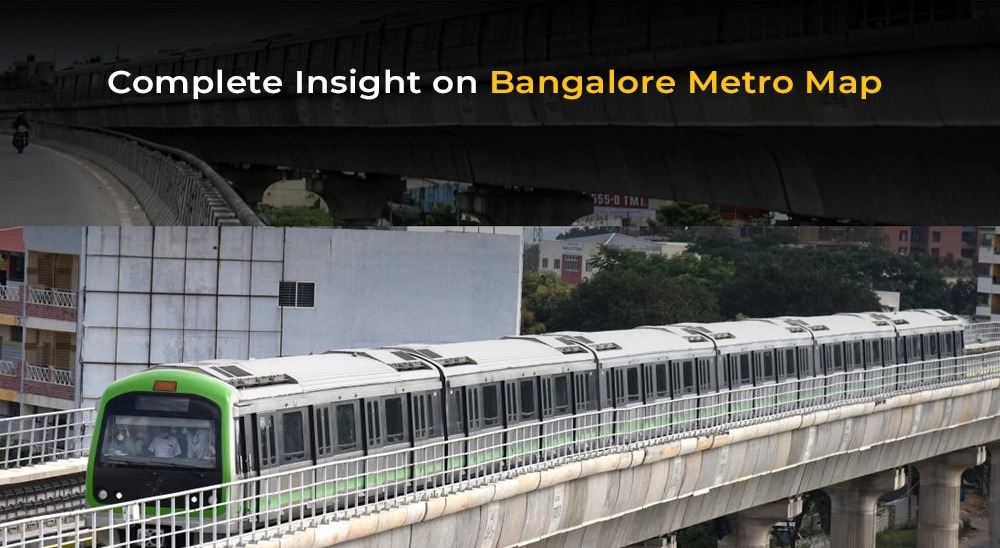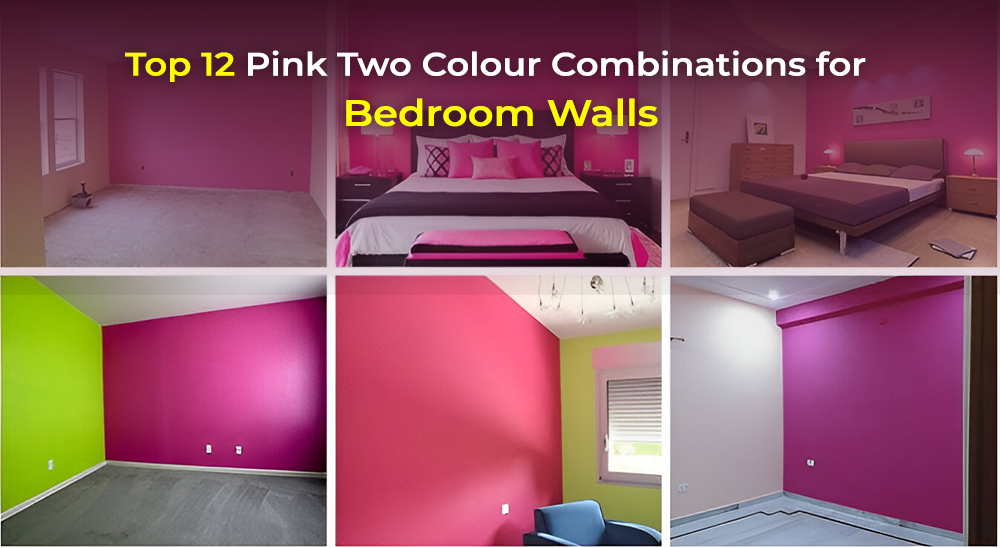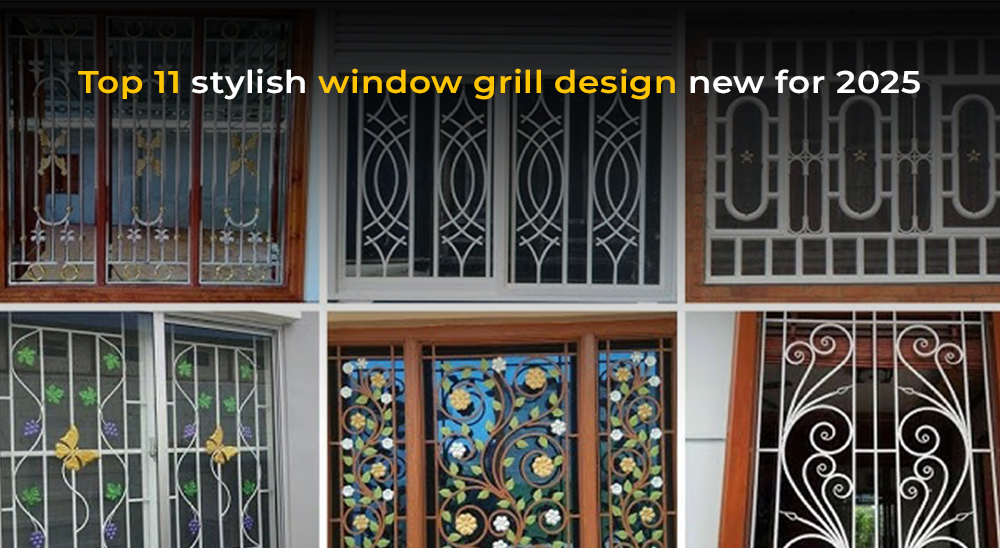Complete Insight on Bangalore Metro Map- Complete Route
Table of Contents
Bangalore Metro, also called the Namma Metro, has changed the city’s overall transportation service. With the city’s growth, the metro has facilitated the mobility of citizens and visitors swiftly at cheap cost and convenience. Bangalore metro lines started in 2011 and currently run the Green and Purple lines. In the coming months, BMRCL will operate the new metro line between Nagasandra and Madavara.
The Yellow line of Bangalore Metro is called the East-West corridor connecting RV Road station to Bommasandra. The almost complete Bangalore Metro yellow line stretches 18.82 kilometers and has 16 stops. Furthermore, the Bangalore Metro’s Yellow Line will have driverless train operations.
This article presents you with insight into the Bangalore metro line and its connection within the city. The readers will find information about the Bangalore metro map, working routes, schedules, and fares below, as well as some key questions and answers pertinent to the system in this article.
Bangalore Metro Route Map
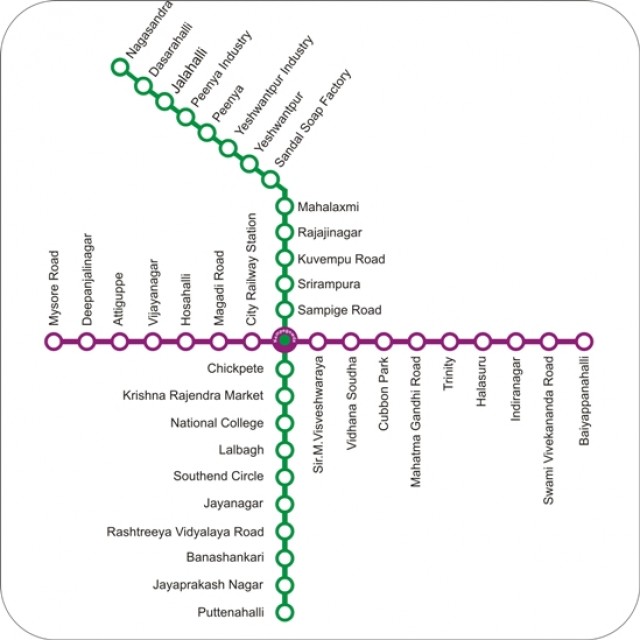
Comprehensive Guide to Bangalore Metro Operational and Planned Lines
Bangalore Metro, or Namma Metro, is a fast and growing transport system that allows people to travel around the congested city. Operated by the Bangalore Metro Rail Corporation Limited (BMRCL), it is currently covering the town slowly, with some of the lines already implemented while some are under construction. With the launch of the Bangalore metro, property rates in many areas of the city have increased by 11% and the commercial rate by 19%.
Bangalore Metro Map and Routes
The Bangalore Metro map is split into principal lines, each connecting specific elements of the city:
• Purple Line: The Purple Line connects Baiyappanahalli in the east to Kengeri in the west, spanning predominant areas along MG Road, Vidhana Soudha, and Mysore Road. This line is essential for east-to-west commuters.
• Green Line: The Green Line connects Nagasandra in the north to Silk Institute in the south, protecting key areas like Yeshwanthpur, Majestic, and Jayanagar. This line is crucial for north-to-south connectivity.
Bangalore Metro has future expansion plans, which include the addition of recent traces and the extension of present ones so that you can further enhance connectivity throughout the metropolis. Currently, additional routes like the Yellow Line are under construction, aiming to serve regions that don’t fall under Purple or Green Lines.
Bangalore Metro Timings
Bangalore metro timings operate every day, with timings that accommodate each early riser and those operating past due.
-
- Regular Timings: The metro generally runs from 5:30 AM to 11:00 PM. However, teaching frequencies might also vary depending on peak hours and weekends.
-
- Peak Hours: During peak hours, which generally vary from 8:00 AM to 11:00 AM and 5:00 PM to 8:00 PM, trains are scheduled each 5–6 mins to handle the high passenger quantity.
-
- Off-Peak Hours: Outside of
-
- height hours, trains are available every 10–15 minutes, allowing for an extra relaxed and much less crowded adventure.
These timings make sure that passengers have reliable carriers at some stage in the day, with additional trains deployed throughout predominant activities or Bangalore metro ticket price list within the city.
Functioning reporting lines of Bangalore Metro Station List
1. Purple Line
– Route: Baiyappanahalli – Kengeri
– Length: Approximately 25.7 km
– Key Stations: Baiyappanahalli, Indiranagar, MG Road, Cubbon Park, Vidhana Soudha, Majestic(Kempegowda interchange), Nayandahalli, Kengeri
– Overview: The Purple Line is the first line of Namma Metro, now operational, and connects from Baiyappanahalli in the eastern part to Kengeri in the western part. This line is for the east-to-west connections and passes through most of the business, educational, and government stations in the city center. Located at Majestic Station, passengers may transfer to the Green Line, which makes travel more convenient.
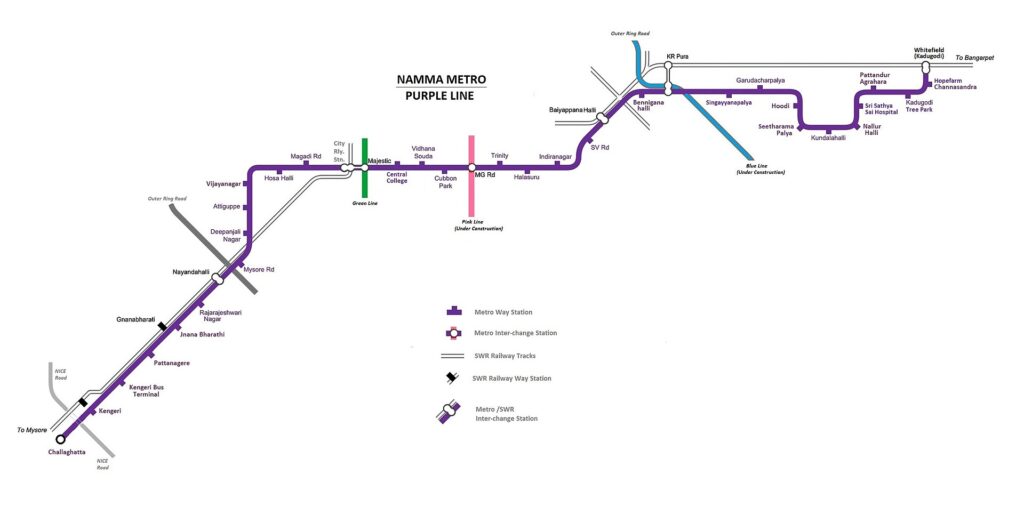
2. Green Line
Route: Nagasandra – Silk Institute
Length: Around 30.5 km
Key Stations: Nagasandra, Yeshwanthapur Signal, Sandal Soap Factory, Rajajinagar Signal, Kempegowda Interchange, Lalbagh Signal, Jayanarag Signal, Banashankari Signal, Yelachenahalli Signal, Silk Institute.
Overview: The Green Line covers the north of Nagasandra to the southern end of the Silk Institute. This runs from north to south and has a good connection to the central business and residential areas. This is because with Majestic as an interchange station passengers can easily transfer to the purple line.
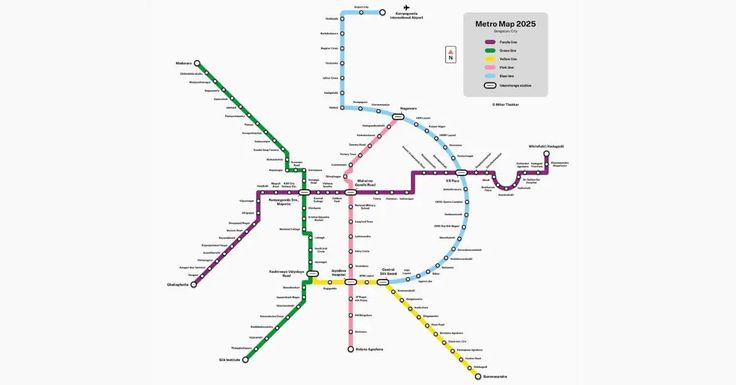
Upcoming Stations to be connected in Bangalore Metro Map.
1. Yellow Line
Route: RV Road – Bommasandra
Length: Approximately 19.1 km
Key Stations: RV Road, Silk board, Bommanahalli, Hosa road, Electronic city, Bommasandra.
Overview: Out of these, only the Yellow Line, which is under construction, will extend from RV Road to Bommasandra, passing through the IT corridor comprising Electronic City. This line is expected to help reduce traffic along Hosur Road by providing IT workers with shorter time to and from the city.
2. Blue Line
Route: Silk Board – KR Puram
Length: Around 17 km
Key Stations: Bangalore Silk Board, HSR Layout, Bellandur, Mahadevapura, KR Puram
Overview: Called the Outer Ring Road line, the Blue Line will run from Silk Board to KR Puram and will link Central Bangalore’s technology and residential regions. This line will be helpful to serve high traffic carrying Outer Ring Road where many IT parks are located and become the daily traffic congestion.
3. Pink Line
Route: Kalena Agrahara (Gottigere) – Nagawara
Length: Approximately 21.2 km
Key Stations: Kalena Agrahara, Hulimavu, Dairy Circle, MG Road, Shivajinagar, Cantonment, Nagawara
Overview: The Pink Line is an elevated line running from the southern part of the city, Kalena Agrahara, to the north, Nagawara. Connecting through heavily congested areas of central Bangalore Metro Route– MG Road and Shivaji Nagar, Pink Line will be a great relief to these busy routes to make them more efficient.
4. Orange Line
Route: Kengeri – Whitefield
Key Stations: Whitefield, Kadugodi, Information Technology Park Limited (ITPL), Hoodi, Baiyappanahalli, Kengeri
Overview: This line will connect Kengeri to the technological city of Whitefield, thus providing much-needed east-to-west connectivity through major IT and residential belts. It will reduce the amount of time people working and living in Whitefield and other areas will spend on the road.
5. Red Line
Route: Kempegowda International Airport – KR Puram
Key Stations: Hebbal, Yelahanka, Bettahalasuru, KIA Terminal
Overview: The Red Line will run from the primary commercial enterprise district of Bangalore metropolis to Kempegowda International Airport and can be a favored mode of delivery when you consider that it’s far quicker than street transport due to traffic congestion. This line shall additionally interconnect with different lines if you want to permit passengers to switch and get to exclusive parts of the metropolis.
6. Light Blue Line
Route: Carmelaram – Yelahanka
Key Stations: Sarjapur road, Carmelaram, Koramangala, Central Silk Board junction, Yelahanka.
Overview: The services of the proposed Light Blue Line will start from the southern extent of the city at Sarjapur and go up to the northern region of Yelahanka. This line will run through several activity centers, such as Koramangala and Central Silk Board, and will link several busy and residential zones.
7. Turquoise Line
Route: Kanakapura Road – Bannerghatta Road – Nagawara
Key Stations: Hulimavu, Dairy Circle, Kanakapura Road, MG Road, Nagawara
Overview: This line will connect the southern and central Bangalore region, Kanakapura Road & Bannerghatta Road to Central City. This addition would enhance the connectivity of the south residents to the other commercial and residential parts of Bangalore through the metro network.
Future Vision of Bangalore Metro Map
As the latest addition to the growing network of metro systems, Bangalore Metro plans to extend its coverage area quickly and help relieve traffic congestion by providing seamless connectivity in the city. The intended lines are envisaged to pass through most commercial, residential, and IT centers to enable daily commuters to use public transport instead of private cars.
Bangalore Metro- QR Code Tickets
Passengers can buy QR code tickets from the Namma Metro mobile application. You will get the QR code, which you can tap at the QR-enabled Automatic Fare Collection gates at the respective metro station.
Conclusion
The large and rapidly growing network of the Bangalore Metro map proves that the city is striving to create a comprehensive system of transport infrastructure for the new generation. The Bangalore Metro system comprises aerial systems, sub-terrain systems, and systems built at par with road level, and the benefits of the city are expected to be a significant reduction of time taken when traveling from one place to another.
The existing and planned metro rail lines will enable the dwellers in different sections of the city to access one another conveniently and relieve Bangalore’s traffic woes through this sustainable means.
FAQs
1. What are the operational hours of Bangalore Metro?
Bangalore Metro operates from 5:00 AM to 11:00 PM daily. Timings may vary on special occasions or during maintenance.
2. How can I check Bangalore Metro ticket prices?
Ticket prices depend on distance, starting from around Rs. 10 for short trips. Fares are displayed at stations and can be checked online.
3. Where can I find the Bangalore Metro map?
Maps are available at all metro stations, the official Bangalore Metro website, and on various travel apps. They show operational and planned routes.
4. Does Bangalore Metro offer smart cards?
Yes, Namma Metro provides reusable smart cards, allowing cashless travel with discounted fares. They can be purchased and recharged at stations.
5. How frequently do Bangalore Metro trains run?
Train frequency varies from 5 to 15 minutes, depending on the time of day and line. Peak hours have shorter intervals.
6. What are the major interchange stations?
The primary interchange is Majestic, connecting the Purple and Green Lines. Additional interchanges will open with future lines to improve connectivity.

